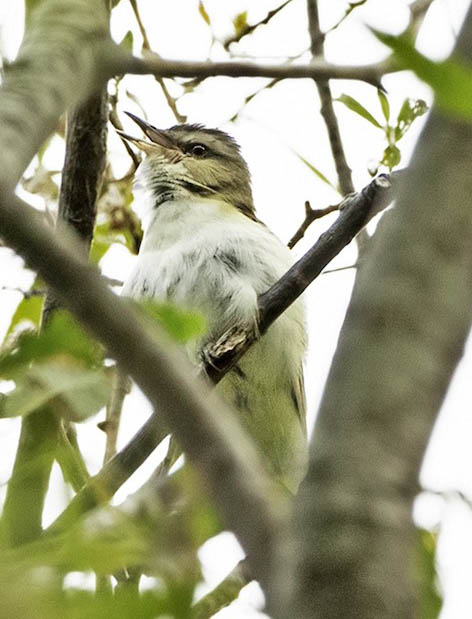| These highlights chronicle the year 2019. The year runs generally
"backwards" on this page. Unlike earlier years, this update includes fewer highlights over a longer period. The abbreviation "MTY" means "Monterey County"
in the text below. Text by Don Roberson. Photos on this page
are copyrighted by the photographers to whom they are
attributed, and may not be reproduced in any form (including
other web sites) without the express consent of the photographer. |
|
 September
2019 started out slowly but ended with a crescendo. Winds shifted from
the SW to a near-gale from the NW by late Saturday afternoon, 28 Sep.
Brian Sullivan, anticipating good seawatching conditions, was at Pt.
Pinos and reported that the "Point was cranking!" He was joined by more
observers who witnessed the unprecedented near-shore passage of Arctic Terns.
In the collage of two photos above, you can see that sea conditions are
rough. The multiple white specks in the sky by the sailboat are Arctic
Terns, as are the tiny terns against the ocean on the right-hand shot
[collage from 28 Sep, left © Oliver Tan; right © D.
Roberson]. One was even photographed on-shore on Moss Landing SB that
day [photo right, © James Maughn. September
2019 started out slowly but ended with a crescendo. Winds shifted from
the SW to a near-gale from the NW by late Saturday afternoon, 28 Sep.
Brian Sullivan, anticipating good seawatching conditions, was at Pt.
Pinos and reported that the "Point was cranking!" He was joined by more
observers who witnessed the unprecedented near-shore passage of Arctic Terns.
In the collage of two photos above, you can see that sea conditions are
rough. The multiple white specks in the sky by the sailboat are Arctic
Terns, as are the tiny terns against the ocean on the right-hand shot
[collage from 28 Sep, left © Oliver Tan; right © D.
Roberson]. One was even photographed on-shore on Moss Landing SB that
day [photo right, © James Maughn.
Brian Sullivan,
writing in eBird, called it an epic flight "mirroring other reports of
remarkable events with this species elsewhere in California this fall."
The flight got heavier as the afternoon progressed; Blake Matheson
estimated 850 in his hour seawatch, in a "slow moving continuous stream
of birds," with another 2000 terns, too distant to be sure of
identification, "like confetti in all directions." Although deep-water
pelagic trips have encountered large offshore migrations of Arctic Tern
(e.g., 2500 on an Aug 1993 pelagic trip), nothing like this has ever
remotely approached these numbers documented by on-shore observers with
scopes. And it wasn't just Arctic Terns. Among these were hundreds of
Elegant Terns, dozens of Sabine's Gulls, up to 380 Parasitic Jaegers in
an hour, two Long-tailed Jaegers chasing terns, at least 3 South Polar
Skua, plus over 600 Buller's Shearwaters and at least 4 Manx
Shearwaters.
|
On
land, the last week of September more than made up for the nearly
vagrant-less first two weeks of the month. And has happened in the
past, there was one specific location that hosted a diverse variety of
rare landbirds within a short period of time.
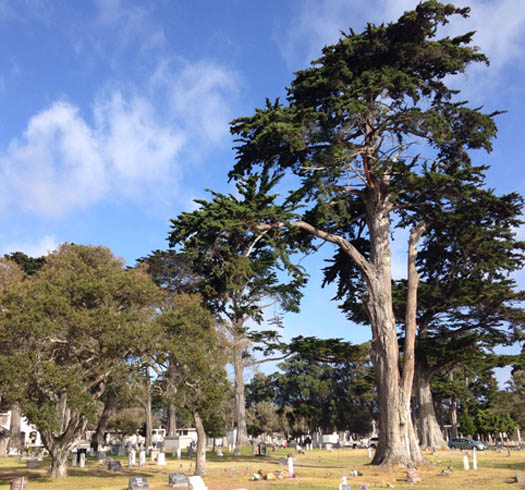 In the past, that has occurred at Pacific Grove's El Carmelo Cemetery [Sep 2014] and at Del Rey Oaks' Frog Pond Nature Reserve [Sep 2018], but this September that spot was Monterey's San Carlos Cemetery,
adjacent to El Estero (photo left, 28 Sep © D. Roberson). During
the period 22–29 Sep, the cemetery hosted a Blackpoll, a
Chestnut-sided, a Blackburnian, a Prairie, 3 or 4 Tennessee Warblers (a
single locale record), and this much-desired Plumbeous Vireo
(below, photo 29 Sep © Rita Carratello). Found initially on 7 Sep
by Paul Fenwick & Brian Sullivan, this was MTY's 33rd record but
the first in fall migration since 2011, and one of few to be documented
by many observers. In the past, that has occurred at Pacific Grove's El Carmelo Cemetery [Sep 2014] and at Del Rey Oaks' Frog Pond Nature Reserve [Sep 2018], but this September that spot was Monterey's San Carlos Cemetery,
adjacent to El Estero (photo left, 28 Sep © D. Roberson). During
the period 22–29 Sep, the cemetery hosted a Blackpoll, a
Chestnut-sided, a Blackburnian, a Prairie, 3 or 4 Tennessee Warblers (a
single locale record), and this much-desired Plumbeous Vireo
(below, photo 29 Sep © Rita Carratello). Found initially on 7 Sep
by Paul Fenwick & Brian Sullivan, this was MTY's 33rd record but
the first in fall migration since 2011, and one of few to be documented
by many observers.
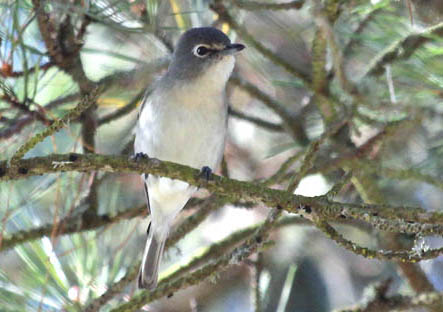
|
During the final third of September, other impressive "eastern" vagrants appeared. The rarest was this Great Crested Flycatcher,
first discovered by Jeff Barnum, and present at Laguna Grande Park from
28 Sep–1 Oct. Four days is a long stay for this species in MTY, and
some observers also got to hear it vocalize. In this photo (right, 28
Sep © Carole Rose), note the heavy bill with pale base to lower
mandible; the very distinctive broad white edgings to the uppermost
tertials; and the tail pattern with the orange-red inner web to each
rectrix extending to the tip of that feather. This Great Crest moved
about but was most often seen in the Virgin Patch, giving moments of deja vu
to those birders who saw a Great Crest in this same spot from 15-17 Oct
2009. The 2019 individual represents the 8th MTY record.
Birders will recall the two singing Yellow-throated Vireos near the Carmel River at Rancho Cañada back in spring 2017, with one lingering to mid-June. Most locals saw one of those. Yet Yellow-throated Vireo
is quite a rarity in MTY, with just 12 records before Paul Fenwick
spotted one while wading in the Carmel River near the Hwy 1 bridge on
10 Sep. Paul also photographed what may be the same individual farther
upstream on 26 Sep {photo below, © Paul Fenwick). This was series
of days in September with strong SW winds, rather than our usual NW
winds, and perhaps there is a correlation to southeastern
(Yellow-throated Vireo) and southwestern birds (Plumbeous Vireo,
Painted Bunting) appearing not long thereafter?
|
|
|
There were two young Painted Bunting
in September, the first appearing off-and-on on small sandbars in the
Carmel River, upstream of Hwy 1, between 18–27 Sep (below left, photo
20 Sep © Carole Rose; Carol first discovered this vagrant). The
second was a greener individual, found initially by Paul Fenwick, that
frequented the small stream that runs into Laguna Grande lake, or an
adjacent patch of tules, between 27-28 Sep (below right, photo 27 Sep
© Don Roberson). These were the 14th and 15th records for MTY, and
were "firsts" for these two eBird Hot Spots.
A
smattering of more expected vagrants occurred during the last two weeks
in September, including a Blue Grosbeak that replaced the Laguna Grande
Painted Bunting in its favored reed patch 29 Sep-1 Oct; an Indigo
Bunting in the general vicinity on 30 Sep; an imm Red-eyed Vireo at
Carmel R. mouth; and various Blackpoll, Chestnut-sided, and
Black-and-white warblers here and there. |
|
|
|
|
 2019 was Rick Fournier's year. 2019 was Rick Fournier's year.
Back on 12 February, Rick discovered Monterey County's first record of Common Eider at Pebble Beach — and only the 3rd for all of California — while leading a bird tour [see winter 2019 highlights].This autumn, on 16 September, Rick found yet another first record for Monterey County (and again while leading a bird trip): a Sulphur-bellied Flycatcher at Pt. Lobos State Reserve! [photo, below right, © Judy Ellyson, a trip participant].
The Pebble Beach Common Eider
remained around Bird Rock for 16 days and birders from throughout
California were able to see it. Rick had a cadre of happy twitchers.
Alas, the Pt. Lobos Sulphur-bellied Flycatcher was
just the opposite. It disappeared quickly after being seen by Rick's
group, reappeared briefly some distance away for a few very lucky
locals, and then dived towards Headland Cove and was never seen again,
dashing the hopes of many locals who came chasing it.
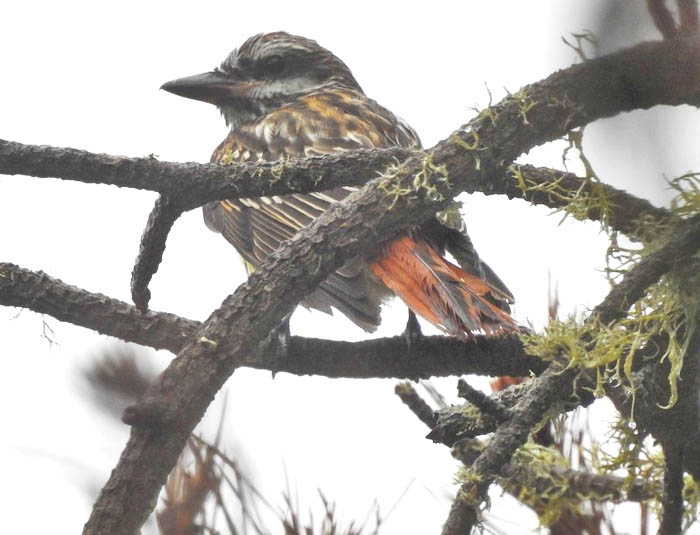 Riverside
and San Luis Obispo county expert Curtis Marantz, who would have chased
this one for his State list had it lingered, summarized the sad litany
of heartbreak this Mexican beauty has caused in California: "This is
the 21st record for the State and the seventh since 2003. With this
one, nine have been from northern California (two each in San Mateo,
Marin, and San Francisco counties, and one each in Humboldt and Sonoma
counties; this is the first for Monterey County). There have been only
four records from southern California since 1992. All but two of the
records are from fall, with now 15 during the period 15 Sep—10 Oct, so
this one was at the early edge of the 'expected' date range. Yet only
seven of the 20 previous birds were seen for more than one day, and at
least several of the others were seen for only brief periods and were
not at all chaseable, even for those nearby. As such, this is one of the most difficult land birds in the State to chase, even on the same day.
The last multi-day bird in California was 18-20 Sep 1999 at Pescadero
Creek, San Mateo County." Curtis has been actively searching for
California birds for decades — and has compiled several very impressive
State year lists — but still has not seen a Sulphur-bellied Flycatcher.
Those who saw the Pt. Lobos bird should consider their good fortune as
pretty much the equivalent to winning the lottery. Riverside
and San Luis Obispo county expert Curtis Marantz, who would have chased
this one for his State list had it lingered, summarized the sad litany
of heartbreak this Mexican beauty has caused in California: "This is
the 21st record for the State and the seventh since 2003. With this
one, nine have been from northern California (two each in San Mateo,
Marin, and San Francisco counties, and one each in Humboldt and Sonoma
counties; this is the first for Monterey County). There have been only
four records from southern California since 1992. All but two of the
records are from fall, with now 15 during the period 15 Sep—10 Oct, so
this one was at the early edge of the 'expected' date range. Yet only
seven of the 20 previous birds were seen for more than one day, and at
least several of the others were seen for only brief periods and were
not at all chaseable, even for those nearby. As such, this is one of the most difficult land birds in the State to chase, even on the same day.
The last multi-day bird in California was 18-20 Sep 1999 at Pescadero
Creek, San Mateo County." Curtis has been actively searching for
California birds for decades — and has compiled several very impressive
State year lists — but still has not seen a Sulphur-bellied Flycatcher.
Those who saw the Pt. Lobos bird should consider their good fortune as
pretty much the equivalent to winning the lottery.
|
|
But
back to Rick Fournier's accomplishment for a moment. As the MTY county
bird list reaches 500 species (currently 1 bird away) it is more and
more difficult to find a new MTY county first-record than it has ever
been before. In the 50 years before 2019, only six observer have
unambiguously documented two different first MTY records within a
single year. That list, with the most recent examples first:
- Brian
Sullivan (2017): Neotropical Cormorant (Aug) & Black-headed Gull
(Nov) — both unchaseable flybys that were photographed;
- Don
Roberson (1986): Blue-headed Vireo (Oct *) & Cassin's Finch (Nov)—
a scattering of records of both species since then; the Finch in
'incursion' years;
- Bob Pitman (1979): Cook's
Petrel & Red-tailed Tropicbird — both on the same Oct research
cruise; many Cook's since then but very few RT tropicbirds;
- Rich
Stallcup (1974): Chestnut-collared Longspur (an Oct boat trip) &
Plumbeous Vireo (the next day*) — both species have occurred
thereafter; and
- Bill Reese (1968):
Chestnut-sided Warbler (Sep) & Greater Pewee (Dec) — over 100
Chestnut-sideds since then but we've still not had another G. Pewee.
*
the former Solitary Vireo was not split into its 3 species
[Blue-headed, Plumbeous, Cassin's] when this individual was discovered,
so it wasn't technically added to the MTY list until the formal split
in 1997. The pre-2002 listings are from Appendix A in Monterey Birds, 2d ed. |
|
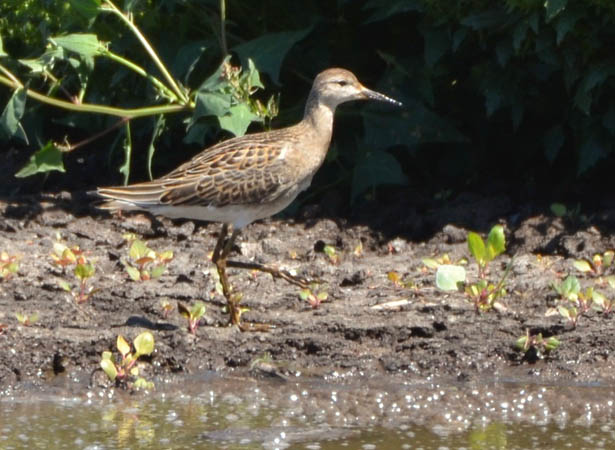 Aside
from the Hudsonian Godwit (see below), it was a comparatively mediocre
year for shorebird migration. The most 'chaseable' Siberian wader in
September was this juvenal-plumage Ruff at Moonglow Dairy, present off-and-on 4–19 Sep (photo right, 6 Sep, © Cooper Scollan). Aside
from the Hudsonian Godwit (see below), it was a comparatively mediocre
year for shorebird migration. The most 'chaseable' Siberian wader in
September was this juvenal-plumage Ruff at Moonglow Dairy, present off-and-on 4–19 Sep (photo right, 6 Sep, © Cooper Scollan).
Another
unusual bird in early October was flushed during the daytime on 3 Sep
by Carole & Larry Rose. It was some sort of Caprimulgid but
opinions varied. It wasn't until dusk that evening when the bird took
to flight that it was confirmed as Lesser Nighthawk (photo below © C. Rose). These breed in far southeastern MTY but are very rare to the coast.
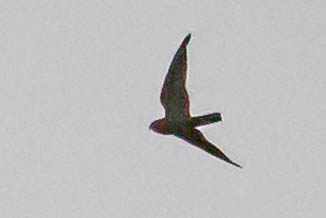
|
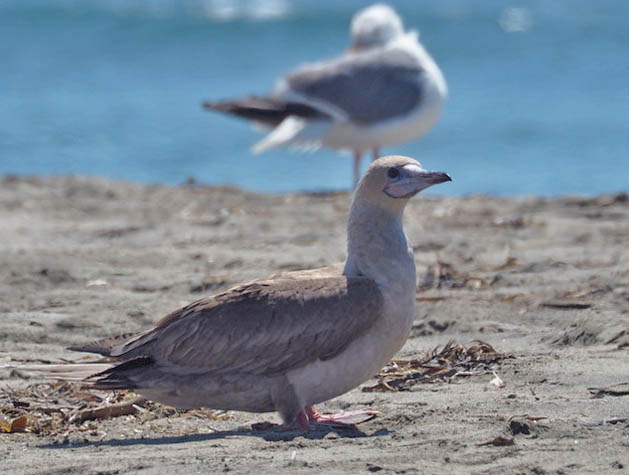 Last
year (2018), MTY had its first Red-footed Boobies since the fall of
1987, at a time when an unprecedented incursion to central and southern
California occurred. Starting last summer, four more Red-foots were
added to the MTY total, both dead and alive, as set out in the summer 2018 highlights and the fall 2018 highlights. Last
year (2018), MTY had its first Red-footed Boobies since the fall of
1987, at a time when an unprecedented incursion to central and southern
California occurred. Starting last summer, four more Red-foots were
added to the MTY total, both dead and alive, as set out in the summer 2018 highlights and the fall 2018 highlights.
As
detailed in those fall highlights, yet another Red-footed Booby started
roosting at Seacliff SB, Santa Cruz Co., beginning on 1 Nov 2018 and
continuing to mid-January 2019, when it disappeared. After a several
month delay, that same booby returned to Seacliff SB, beginning on 28
May 2019 and continuing off-and-on to mid-August, with an occasional
appearance at other State Parks around Santa Cruz. We presume it was
this same Red-footed Booby that James Maughn found
sitting on Zmudowski State Beach on 20 August (photo left, © James
Maughn). Alas, it was shortly thereafter flushed by an off-leash dog
and flew north, back into SCZ. |
 Shorebird
migration started with some real excitement on 1 August. Rita
Carratello, leading her adult education bird class, discovered this
juvenal-plumaged Hudsonian Godwit at the shallow pond
at the Salinas River NWR. It remained to 7 August, the photos here are
from 2 Aug (right, © Rita Carratello) and 7 Aug (below, © Don
Roberson). Shorebird
migration started with some real excitement on 1 August. Rita
Carratello, leading her adult education bird class, discovered this
juvenal-plumaged Hudsonian Godwit at the shallow pond
at the Salinas River NWR. It remained to 7 August, the photos here are
from 2 Aug (right, © Rita Carratello) and 7 Aug (below, © Don
Roberson).
Hudsonian Godwit is a CBRC review species,
and their most recent postings suggest this is the 51st record for the
State of California. It is the earliest juvenal-plumaged Hudsonian ever
in California (how fast can you say "global warming"?
It
is just the 3d record for MTY. The CBRC considers one at Carmel River
mouth on 28 Aug 1988 to be the same bird that settled in at Salinas
River mouth a few days later and remained to 3 Oct 1988. The second
record was at the Salinas WTP from 8-20 Sep 2007.
|
|
|
We had two scarce terns visit MTY over the summer months. Three of them were Black Tern:
an adult in breeding plumage on 1-2 June at Zmudowski, a juv at Salinas
R. NWR on 6 Aug (above right, photo © Lee-Hong Chang, courtesy of
Earl Lebow), and a juv over Estrada Marsh, next to Elkhorn Slough, on
11-13 August. A handful visit MTY during this date span annually, but
one has to be at the right place at the right time. The other species
was Least Tern. An adult was Zmudowski State Beach
pond from 18-19 Aug (photo above left, from 18 Aug, © Paul
Fenwick). Note that Paul's nice photo shows this adult to be banded on
its right leg.
There has been a colony of breeding California Least Tern
in San Francisco Bay. This west coast breeder, the subspecies called
"California Least Tern" and formally known as Sterna antillarum browni,
is an endangered species. Least Terns have been nesting on a runway at
the old Alameda Naval Air Station since the 1970s. The Air Station was
decommissioned in 1994 and the tern colony continued to increase. It
received formal protection in 2012. Since 2002, the Alameda colony has
become one of the most important California Least Tern breeding sites
in the world. It has consistently produced more fledglings than other
colonies four or five times its size in Southern California because the
unique features of the runway and lack of human disturbance make the
site more manageable. In many years it has 300 or more pairs nesting.
The Alameda colony is the anchor for the Northern California population
of California Least Terns and has been seeding other, smaller colonies
in the Bay Area (info from Golden Gate Audubon). California Least Terns
winter in Central America. Therefore, we believe the entire colony
migrates to and from Alameda via the coast of MTY. Yet the overall
numbers are so small, and their journey so determined, that they don't
linger long here and a birder is quite lucky to see even one a year in
our county during spring or fall migration. Presumably the band on this
year's Zmudowski bird was placed by researchers at Alameda when it was
a nestling there. |
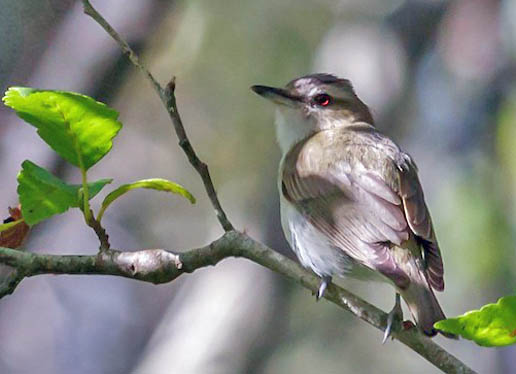 |
|
The second half of 2019 started with Michael Rieser's discovery of a singing Red-eyed Vireo
near the Carmel River mouth on 7 July. Michael recorded the song but
initially the vireo could not be seen in thick riparian woods with a
heavy understory of poison oak. In subsequent days, though, Michael
refound it and obtained photos, as did others. The photo above
highlights the bright red eye of this adult (photo 10 July ©
Carole Rose), and the photo right shows the bird in full song (photo 11
July © Bill Hill). Both birds lingered late into summer.
Red-eyed Vireo is an eastern vagrant to California —
and always rare here — but there are several prior records of these
vireos attempting to summer locally. There were July records along the
Big Sur or Carmel Rivers in 1993, 1994, 1997, and 2000, and birds in
mid-August in 2004 and 2012. It is possible that all of these
individuals were attempting to summer locally. Summer vireos are quite
unexpected; most of our Red-eyed Vireos are vagrants in spring or fall
migration. |
|
|
|
TOP
GO TO
HOME PAGE
TO MONTEREY
COUNTY
PAGE
TO BIRD
FAMILIES
OF THE WORLD
|

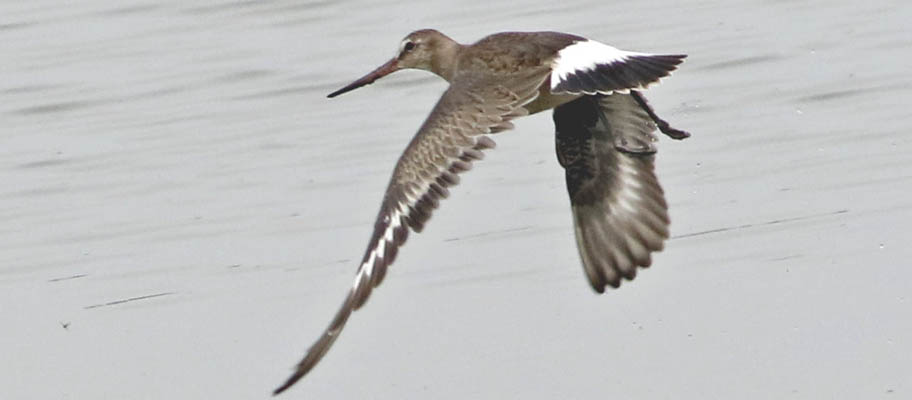
 September
2019 started out slowly but ended with a crescendo. Winds shifted from
the SW to a near-gale from the NW by late Saturday afternoon, 28 Sep.
Brian Sullivan, anticipating good seawatching conditions, was at Pt.
Pinos and reported that the "Point was cranking!" He was joined by more
observers who witnessed the unprecedented near-shore passage of Arctic Terns.
In the collage of two photos above, you can see that sea conditions are
rough. The multiple white specks in the sky by the sailboat are Arctic
Terns, as are the tiny terns against the ocean on the right-hand shot
[collage from 28 Sep, left © Oliver Tan; right © D.
Roberson]. One was even photographed on-shore on Moss Landing SB that
day [photo right, © James Maughn.
September
2019 started out slowly but ended with a crescendo. Winds shifted from
the SW to a near-gale from the NW by late Saturday afternoon, 28 Sep.
Brian Sullivan, anticipating good seawatching conditions, was at Pt.
Pinos and reported that the "Point was cranking!" He was joined by more
observers who witnessed the unprecedented near-shore passage of Arctic Terns.
In the collage of two photos above, you can see that sea conditions are
rough. The multiple white specks in the sky by the sailboat are Arctic
Terns, as are the tiny terns against the ocean on the right-hand shot
[collage from 28 Sep, left © Oliver Tan; right © D.
Roberson]. One was even photographed on-shore on Moss Landing SB that
day [photo right, © James Maughn. In the past, that has occurred at Pacific Grove's El Carmelo Cemetery [
In the past, that has occurred at Pacific Grove's El Carmelo Cemetery [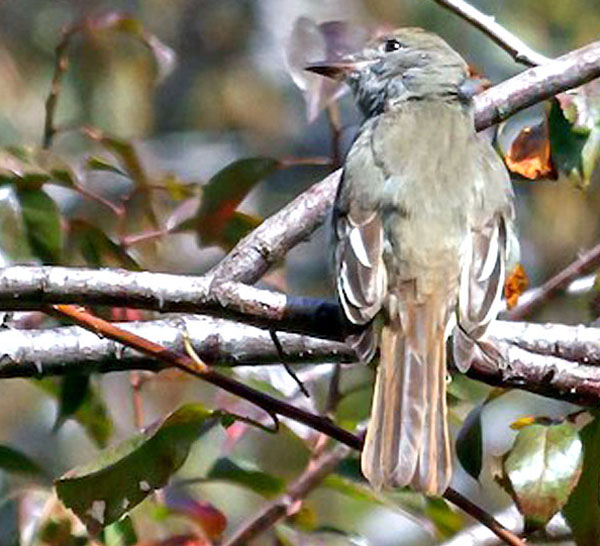


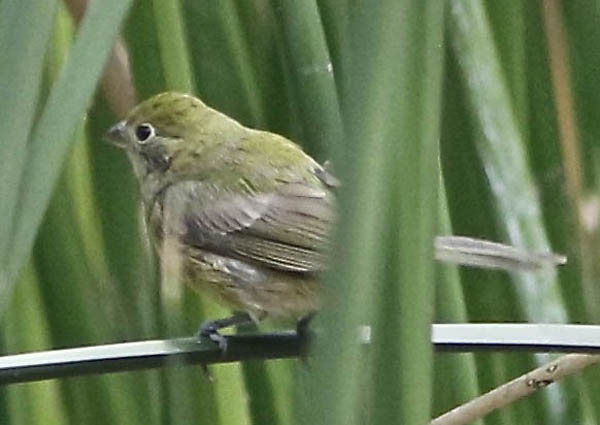
 2019 was Rick Fournier's year.
2019 was Rick Fournier's year.  Riverside
and San Luis Obispo county expert Curtis Marantz, who would have chased
this one for his State list had it lingered, summarized the sad litany
of heartbreak this Mexican beauty has caused in California: "This is
the 21st record for the State and the seventh since 2003. With this
one, nine have been from northern California (two each in San Mateo,
Marin, and San Francisco counties, and one each in Humboldt and Sonoma
counties; this is the first for Monterey County). There have been only
four records from southern California since 1992. All but two of the
records are from fall, with now 15 during the period 15 Sep—10 Oct, so
this one was at the early edge of the 'expected' date range. Yet only
seven of the 20 previous birds were seen for more than one day, and at
least several of the others were seen for only brief periods and were
not at all chaseable, even for those nearby. As such, this is one of the most difficult land birds in the State to chase, even on the same day.
The last multi-day bird in California was 18-20 Sep 1999 at Pescadero
Creek, San Mateo County." Curtis has been actively searching for
California birds for decades — and has compiled several very impressive
State year lists — but still has not seen a Sulphur-bellied Flycatcher.
Those who saw the Pt. Lobos bird should consider their good fortune as
pretty much the equivalent to winning the lottery.
Riverside
and San Luis Obispo county expert Curtis Marantz, who would have chased
this one for his State list had it lingered, summarized the sad litany
of heartbreak this Mexican beauty has caused in California: "This is
the 21st record for the State and the seventh since 2003. With this
one, nine have been from northern California (two each in San Mateo,
Marin, and San Francisco counties, and one each in Humboldt and Sonoma
counties; this is the first for Monterey County). There have been only
four records from southern California since 1992. All but two of the
records are from fall, with now 15 during the period 15 Sep—10 Oct, so
this one was at the early edge of the 'expected' date range. Yet only
seven of the 20 previous birds were seen for more than one day, and at
least several of the others were seen for only brief periods and were
not at all chaseable, even for those nearby. As such, this is one of the most difficult land birds in the State to chase, even on the same day.
The last multi-day bird in California was 18-20 Sep 1999 at Pescadero
Creek, San Mateo County." Curtis has been actively searching for
California birds for decades — and has compiled several very impressive
State year lists — but still has not seen a Sulphur-bellied Flycatcher.
Those who saw the Pt. Lobos bird should consider their good fortune as
pretty much the equivalent to winning the lottery.  Aside
from the Hudsonian Godwit (see below), it was a comparatively mediocre
year for shorebird migration. The most 'chaseable' Siberian wader in
September was this juvenal-plumage Ruff at Moonglow Dairy, present off-and-on 4–19 Sep (photo right, 6 Sep, © Cooper Scollan).
Aside
from the Hudsonian Godwit (see below), it was a comparatively mediocre
year for shorebird migration. The most 'chaseable' Siberian wader in
September was this juvenal-plumage Ruff at Moonglow Dairy, present off-and-on 4–19 Sep (photo right, 6 Sep, © Cooper Scollan). 
 Last
year (2018), MTY had its first Red-footed Boobies since the fall of
1987, at a time when an unprecedented incursion to central and southern
California occurred. Starting last summer, four more Red-foots were
added to the MTY total, both dead and alive, as set out in the
Last
year (2018), MTY had its first Red-footed Boobies since the fall of
1987, at a time when an unprecedented incursion to central and southern
California occurred. Starting last summer, four more Red-foots were
added to the MTY total, both dead and alive, as set out in the  Shorebird
migration started with some real excitement on 1 August. Rita
Carratello, leading her adult education bird class, discovered this
juvenal-plumaged Hudsonian Godwit at the shallow pond
at the Salinas River NWR. It remained to 7 August, the photos here are
from 2 Aug (right, © Rita Carratello) and 7 Aug (below, © Don
Roberson).
Shorebird
migration started with some real excitement on 1 August. Rita
Carratello, leading her adult education bird class, discovered this
juvenal-plumaged Hudsonian Godwit at the shallow pond
at the Salinas River NWR. It remained to 7 August, the photos here are
from 2 Aug (right, © Rita Carratello) and 7 Aug (below, © Don
Roberson). 


